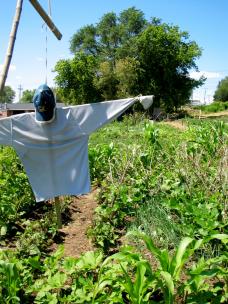






 It is dusk in mid-July and community gardeners at the Badger Fountain of Life Garden are calling it a day. They are returning tools and watering cans to their appropriate places. Stacks of harvested crops, many not indigenous to Madison, are ready to be taken home, washed, cooked and eaten. But before heading home, the families, many refugees from the Asian country of Bhutan, wave good-bye to those still working in the garden.
It is dusk in mid-July and community gardeners at the Badger Fountain of Life Garden are calling it a day. They are returning tools and watering cans to their appropriate places. Stacks of harvested crops, many not indigenous to Madison, are ready to be taken home, washed, cooked and eaten. But before heading home, the families, many refugees from the Asian country of Bhutan, wave good-bye to those still working in the garden.
While this scene may resemble the “happily ever after” ending of a movie, it is actually what one encounters at a once barren plot behind the Fountain of Life Worship Center in Madison.
The garden originated from a seedling of an idea that Blessed Sacrament Church parishioners, Kate Kollman and Mark Landgraff came up with one night in 2010. Over dinner, while discussing the lack of fresh and healthy food sources for many Madison families, they decided a community garden was at least one solution.
Soon after, Landgraff contacted Pastor Alexander Gee Jr. of the Fountain of Life Worship Center on Madison’s Eastside about establishing a garden on a sizable piece of vacant land behind the center. Pastor Gee welcomed the idea, since the space was prone to “vandalism and crime in the past,” says Kollman.
An unusual collaboration, since as Pastor Gee points out, “most churches are not offering space for gardens,” the partnering between Blessed Sacrament, Fountain of Life, the Community Action Coalition (CAC), and Queen of Peace School, where Kollman teaches third grade, has resulted in a flourishing garden that has become an important part of the Southside community. The garden now boasts roughly 75 plots.
Many of the 10x12 plots grow traditional Wisconsin crops such as corn, tomatoes, onions and peppers that one can spot from the mulched woodchip trails that run between them. As one walks through the Garden, the daily hard work from long-time Madison residents and Bhutanese refugees is readily apparent.
The newly-arrived Bhutanese immigrants are Lhothampas, an ethnic group within Bhutan. They came to the United States from refugee camps in Nepal after facing eviction by the Bhutanese government in the 1990’s. Over the past four years, 60,000 of these Bhutan refugees have been relocated to the United States. Madison is now home to almost 200 of them, according to a February article in the Wisconsin State Journal.
To many of these Bhutanese families, the Badger Fountain of Life Garden has provided tools that go well beyond a rake and a watering can. The garden helps them “start a new chapter in their lives,” says Joe Mathers, a CAC garden specialist.
“At the garden, the Bhutanese refugees can connect, congregate and socialize with people they may have never crossed paths with otherwise,” says Kara Slaughter, another founding participant of the Garden.
Not only does the Garden continually facilitate the adjustment of new refugee families arriving each week, it also helps them keep their culinary culture. Among others crops, their plots feature maize and rice, two staple crops in Bhutan.
In addition to Bhutanese residents, the garden also serves other Madison communities. A special section is reserved for the Allied Drive Food Pantry, which receives fresh produce from the garden every week. The local Boys & Girls Club and the Fountain of Life Youth Group also have their own plots in the garden, where they get to experience the process and planning that goes into growing one’s own food.
Everyone involved in the garden, including Kollman, Slaughter and Pastor Gee call it a success, considering the amount of food it donates to the pantry and low-income families of the neighborhood.
But, with the garden at full capacity, they are scouting for new locations, and in the future, Pastor Gee would also like to see a Community Harvest Celebration and a Farmers’ Market.
When asked to describe the garden’s mission, Kate Kollman said the founders simply wanted to provide “healthy, organic food to low-income families who might not otherwise have the means and resources to acquire it on their own.
It is safe to say that they have achieved this, and so much more. They have given a gift that keeps on giving—literally—to their community and its newest residents.
For more pictures from the garden, check out the slideshow below:
Also contributing to this story: Lonnie Malik Anderson, Leticia Martinez, Kaewsuwan Xiong, and Dhool Siad (photography)
|
|
|
Welcome to the Madison Commons, a website designed to provide news and information about all of Madison's neighborhoods and a crossroads for the discussion of community issues. The name comes from the idea of a village commons, a place for news, talk, debate, and some entertainment, too, that's open to everyone.
All rights reserved. Read more about the Madison Commons and its partners.


Comments
The garden proyect
Great Article!
It is nice to know, people care for the land and for cultivating lasting relationships.
Good job to the writter!